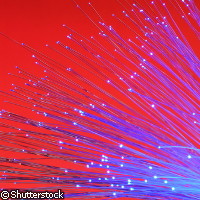'Father of Fibre Optics' and digital photography pioneers share Nobel Prize in Physics
That you are able to read this article and view the accompanying picture is due in no small part to the work of the three scientists who have just been awarded the 2009 Nobel Prize in Physics. The British-American physicist Charles Kuen Kao of Standard Telecommunication Laboratories in the UK and the Chinese University of Hong Kong in China has been awarded half of the SEK 10 million (EUR 976,000) prize 'for groundbreaking achievements concerning the transmission of light in fibres for optical communication'. As long ago as the 1930s, doctors were using short optical fibres to examine their patients internally or to illuminate teeth during dental surgery. However, these fibres became worn out rather quickly and could only transmit light over very short distances. During the 1960s, the invention of the laser allowed focused beams of light to be pumped directly into optical fibres. However, even these laser signals faded rapidly: after just 20 metres, only 1% of the light that had entered the fibre remained. Born in 1933 in Shanghai, China, Charles Kao gained a PhD in electrical engineering from Imperial College London in the UK in 1965. By this time, he was already working at Standard Telecommunication Laboratories, where he studied glass fibres in detail with his colleague George Hockham. In January 1966, the two partners presented their results. They suggested that impurities in the glass were reducing the efficiency of optical fibres. Transferring light over long distances would require the manufacture of truly pure, transparent glass. Glass of such transparency had never been made before. Nevertheless, just four years later, an American glass manufacturer succeeded in making an extremely pure optical fibre measuring one kilometre in length. Today, over a billion kilometres of optical fibre carry telephone calls, texts, images and other data around the world at the speed of light. '[Professor Kao] developed the principles of fibre optics with his own insight and turned optical fibre communication into reality, eventually heralding the age of the Internet,' said Lawrence Lau, Vice-Chancellor of the Chinese University of Hong Kong. 'The high-speed network communication that is now such an integral part of modern living owes much to Professor Charles Kao, the trailblazer.' The other half of the award is shared jointly by William Boyle and George Smith of Bell Laboratories in the US 'for the invention of an imaging semiconductor circuit - the CCD [charge-coupled device] sensor'. The CCD is the 'electronic eye' at the heart of the digital camera. The device is based on the photoelectric effect (which, incidentally, won Albert Einstein the Nobel Prize in Physics in 1921). Under the photoelectric effect, light is transformed into electrical signals. The CCD is effectively an array of 'photocells' that emit different amounts of electrons depending on the intensity of the light hitting them. The electron content of each photocell can then be read out, turning an optical image into a digital one. Different filters enable colour images to be generated. As well as revolutionising photography, the CCD is widely used in medicine for imaging the inside of the body. 'Digital photography has become an irreplaceable tool in many fields of research,' reads a statement from the Nobel Foundation. 'The CCD has provided new possibilities to visualise the previously unseen. It has given us crystal clear images of distant places in our universe as well as the depths of the ocean.' And, needless to say, Professor Kao's optical cables are vital in allowing us to send images taken with the help of CCDs around the world.
Countries
Canada, United Kingdom, United States



